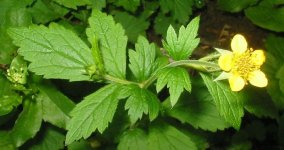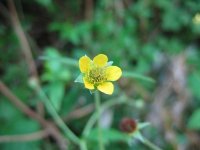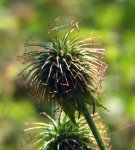Gravelite urban - geum urbanum l.
Family Rosaceae - Rosaceae
Botanical characteristics. Perennial herbaceous plant. It grows everywhere.
Rhizome creeping, thick. Stem erect, in the upper part branched. The lower leaves forming the rosette are lyrate-pinnate, long-petioled, cauline - short-petiolate, upper - sessile, tripartite, with large ovate stipules. Flowers are light yellow, solitary, with five petals, located on the tops of stalks and lateral branches. Fruit is a collection nut, consists of numerous single-seeded nuts with an obovate shape. Flowering and fruiting occurs in the second year, in the first year only a rosette of leaves is formed. Blossoms in May - June, fruits ripen in July - August.
Used parts of the plant. The medicinal raw material is the aboveground part and roots. The aerial part is collected during flowering, the roots in late autumn.
Chemical composition. Tannins, glycosides, flavonoids, carbohydrates and related compounds, organic acids, nitrogen-containing compounds, tannins, vitamins, microelements, pigments, essential oil, eugenol (clove oil) and other compounds have been found in the plant.
Application. Gravilite city has anti-inflammatory, expectorant, astringent, soothing, weak sleeping pills, choleretic, hemostatic, analgesic, tonic, antiseptic, increases blood coagulability.
As a medicinal plant it has been used since ancient times. Decoction of the roots and the aerial part of the gravel is used for bleeding, a headache that is soothing, with inflammation of the upper respiratory tract, for separating sputum from coughing, bronchial asthma, with articular and muscular rheumatism, catarrh of the stomach, dysentery, colitis, flatulence, hemorrhoids, kidney diseases And liver, cholecystitis, nephritis; In stomatology - for the treatment of periodontal diseases, stomatitis, gingivitis, inflammatory diseases of the oral cavity; Externally - with eye diseases in the form of baths - with skin diseases and rickets in children, scrofululosis, dislocations, often mixed with other herbs.
Gravilite removes spastic actions of barium chloride, is an effective remedy against snake venom and bites of poisonous insects. It is taken to increase and increase potency in men.
In Tibetan medicine, the roots of gravel are used in diarrhea, as an astringent, hemostatic, antipyretic, laxative, fixing, in diseases of the gastrointestinal tract; In eastern traditional medicine - with pulmonary tuberculosis and other pulmonary diseases.
Preparation
- Young leaves can be eaten as a salad. Rhizome, which has a clove-like odor, is used as a seasoning for dishes instead of cinnamon and cloves.
- For broth 15 g of roots are ground, pour 200 ml of boiling water, insist on a boiling water bath for 30 minutes, cool for 10 minutes, without removing from the bath at room temperature, filter. Take 1/3 cup 2-3 times a day after meals.
Contraindications. Since the preparations of city's gravelite increase the coagulability of blood, it is not recommended to take them with thrombophlebitis and propensity to thrombosis.





Comments
When commenting on, remember that the content and tone of your message can hurt the feelings of real people, show respect and tolerance to your interlocutors even if you do not share their opinion, your behavior in the conditions of freedom of expression and anonymity provided by the Internet, changes Not only virtual, but also the real world. All comments are hidden from the index, spam is controlled.